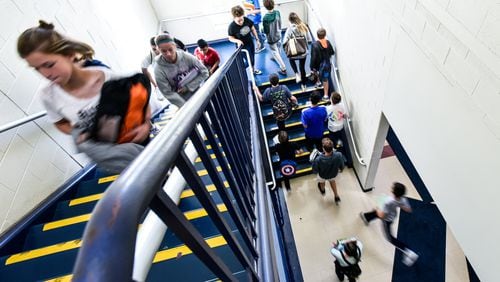I was driving by my local high school Monday at dismissal and was struck by how young the freshmen looked compared to the seniors. I even spotted a beard or two among the older students.
Several neighbors with freshmen have shared their concerns about having their “babies” in school with 18-year-olds. They worry not only about bullying but about their teens emulating dangerous behaviors in an attempt to appear older and cooler.
I can’t recall having much contact with older students when I was in high school, but I attended an all-girls Catholic school with rigid grade distinctions. I did not have any classes with students outside my grade, including PE.
Last week, I wrote on the blog about an incident between a Cobb County high school freshman and a senior. The older boy was "picking at" the freshman -- to quote the description used by the Harrison High assistant principal -- and the younger kid fought back, leading to felony assault and battery charges against him. The school's actions in the case have stirred controversy and criticism in Cobb.
The story made me wonder about the strategy in some schools of keeping younger kids away from older ones through such innovations as ninth grade academies.
Such academies – either a separate wing or building -- are typically found in big high schools and are seen as a way to ease the transition to high school and keep kids from failing or dropping out. Research suggests the first year in high school is pivotal for setting a tone that keeps children in school and more attention ought to be paid to the ninth-grade experience.
As a U.S. Department of Education guide "Ninth Grade Counts" states:
Ninth grade is a potential minefield for many young adolescents. During the freshman year, incoming students encounter new emotions, new social situations, and new intellectual challenges. And they also begin creating an enduring academic record that will either open up a world of exciting opportunities upon graduation or prematurely foreclose on their collegiate and career prospects. We know that more students fail ninth grade than any other grade, creating what has been called the "ninth-grade bump"— struggling, off-track students are held back by negative self-beliefs, a lack of credits, and an inability to recover from past failures, and the freshman class swells to become the largest in the high school. We also know that many students enter high school performing two or even three years below grade level, and that these students are most at risk of continued failure or dropping out. At the same time, we also know that early warning signs—such as irregular attendance, persistent behavioral issues, and poor grades in middle and elementary school—are often predictive of high school underperformance or a failure to graduate. If educators monitor early warning signs, and if they take proactive steps to strengthen the ninth-grade transition, fewer students will fail and more will graduate prepared for college and the modern workplace.
North Carolina was among the first states to embrace ninth grade academies. As this study out of North Carolina explains:
Freshman academies provide incoming ninth grade students with additional resources and personalized support to overcome transitional obstacles…Ninth graders are adolescents undergoing the difficult transition from middle school to high school. As they face the social, emotional, physical and intellectual challenges of this stage of development, it is easy for them to feel overwhelmed, confused and alone. Subsequently, over the last thirty years the national average for ninth grade non-promotion has more than tripled from approximately four percent to thirteen percent. This retention creates the "ninth grade bulge" and "tenth grade dip" as fewer students are promoted to the next grade.
A 2013 study out of Florida examined Broward County's ninth grade academies at its 18 high schools and found challenges in leadership, implementation and commitment to the concept. (The academies can also present scheduling nightmares.)
The study said:
While the district's initiative to implement ninth-grade academies districtwide was bold in many respects, many schools struggled to implement this complex and multifaceted reform. Although every high school in the study sample attempted to implement ninth-grade academy structures and practices, the research team discovered strong and sustained ninth grade academy implementation in only three schools. In each of the first three years of their ninth-grade academies, all three of these schools achieved strong implementation of three core components — dedicated administrator, space, and faculty — and threshold or strong implementation of the interdisciplinary teaming component. These schools were characterized by committed and creative leaders, skilled schedulers, and low or well managed turnover in key positions.
Are ninth graders generally kept apart from older students at your area high schools? Should there be more separation or less?
An argument in favor of more exposure is that teens can learn from older classmates. (I mentioned that to a friend, and she said the only thing her son learned from older boys at his school was how to vape.)
However, another parent said the support and encouragment of older teens in the high school band prevented her daughter from quitting in frustration as a freshman. And band turned out to be the highlight of her daughter’s high school experience.
Your thoughts?







